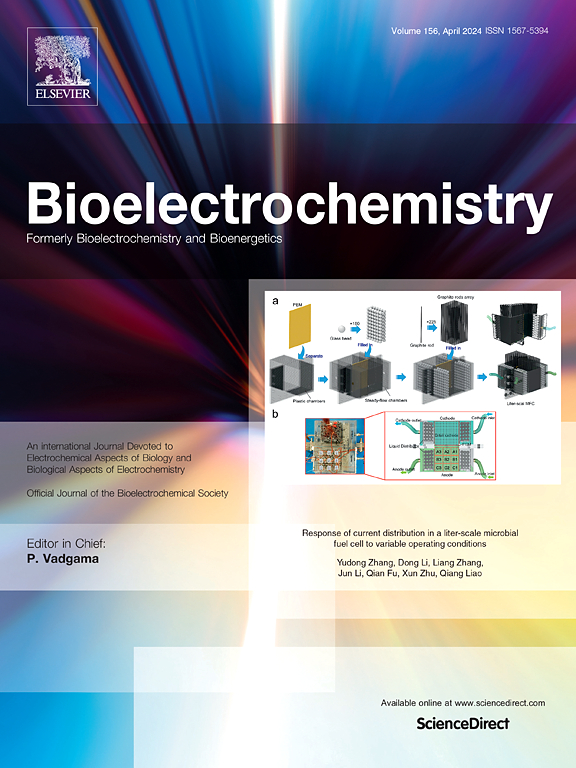基于 WO3/CdS 异质结的信号光电化学适配传感器,用于超灵敏检测卡那霉素
IF 4.8
2区 化学
Q1 BIOCHEMISTRY & MOLECULAR BIOLOGY
引用次数: 0
摘要
本研究以 WO3/CdS 异质结为光活性材料,构建了一种超灵敏测定卡那霉素(KANA)的信号光电化学(PEC)传感器。首先,通过简单的共沉淀方法成功制备了具有优异光电响应的 WO3/CdS 异质结,从而获得了强大而稳定的初始光电流。此外,利用戊二醛将氨基修饰的aptamers固定在电极表面,作为生物识别元件。在目标 KANA 存在的情况下,它会被适配体特异性识别和捕获。更重要的是,由于光生空穴对 KANA 的氧化作用,KANA 可作为信号放大器增强光电流。因此,基于 WO3/CdS 异质结的高选择性信号型 PEC 媒介传感器可用于检测 KANA。在优化的实验条件下,该 PEC 亲和传感器的线性范围为 10 pM 至 400 nM,检测限为 6.77 pM。同时,所设计的 PEC 合传感器已成功用于牛奶、鱼、血清和水等样品的分析检测。本文章由计算机程序翻译,如有差异,请以英文原文为准。
A signal-on photoelectrochemical aptasensor based on WO3/CdS heterojunction for the ultrasensitive detection of kanamycin
In this study, a signal-on photoelectrochemical (PEC) aptasensor for the ultrasensitive determination of kanamycin (KANA) was constructed using WO3/CdS heterojunction as photoactive material. Firstly, WO3/CdS heterojunction with excellent photoelectric response was successfully prepared by simple co-precipitation method, resulting in a strong and stable initial photocurrent. In addition, amino modified aptamers were immobilized on the electrode surface by glutaraldehyde as biological recognition components. In the presence of the target KANA, it is specifically recognized and captured by the aptamers. More importantly, KANA can act as a signal amplifier to enhance the photocurrent due to the oxidation of KANA by photogenerated holes. Therefore, a signal-on PEC aptasensor based on WO3/CdS heterojunction with high selectivity was obtained for the detection of KANA. Under optimized experimental conditions, the PEC aptasensor demonstrated a wide linear range of 10 pM to 400 nM, with a detection limit of 6.77 pM. Meanwhile, the designed PEC aptasensor had been successfully utilized for the analytical examination of milk, fish, serum, and water samples.
求助全文
通过发布文献求助,成功后即可免费获取论文全文。
去求助
来源期刊

Bioelectrochemistry
生物-电化学
CiteScore
9.10
自引率
6.00%
发文量
238
审稿时长
38 days
期刊介绍:
An International Journal Devoted to Electrochemical Aspects of Biology and Biological Aspects of Electrochemistry
Bioelectrochemistry is an international journal devoted to electrochemical principles in biology and biological aspects of electrochemistry. It publishes experimental and theoretical papers dealing with the electrochemical aspects of:
• Electrified interfaces (electric double layers, adsorption, electron transfer, protein electrochemistry, basic principles of biosensors, biosensor interfaces and bio-nanosensor design and construction.
• Electric and magnetic field effects (field-dependent processes, field interactions with molecules, intramolecular field effects, sensory systems for electric and magnetic fields, molecular and cellular mechanisms)
• Bioenergetics and signal transduction (energy conversion, photosynthetic and visual membranes)
• Biomembranes and model membranes (thermodynamics and mechanics, membrane transport, electroporation, fusion and insertion)
• Electrochemical applications in medicine and biotechnology (drug delivery and gene transfer to cells and tissues, iontophoresis, skin electroporation, injury and repair).
• Organization and use of arrays in-vitro and in-vivo, including as part of feedback control.
• Electrochemical interrogation of biofilms as generated by microorganisms and tissue reaction associated with medical implants.
 求助内容:
求助内容: 应助结果提醒方式:
应助结果提醒方式:


